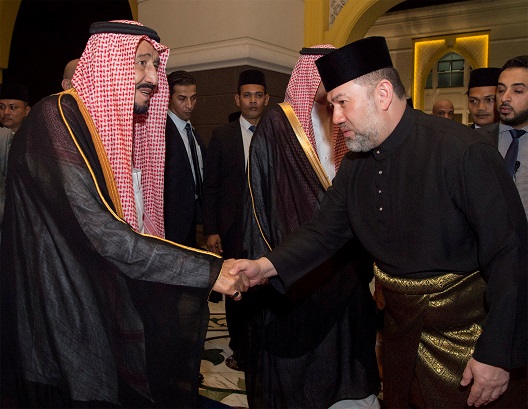 Saudi Arabia’s King Salman bin Abdulaziz al-Saud is currently engaged in a tour in Asia, which will last about a month. Five out of six of the countries he is visiting are Muslim majority nations (the sixth, China, has a significant and ancient Muslim minority population). While there is undoubtedly a financial and economic aspect to this trip, there is also a deep quasi-cultural element to it as well that bears close attention as this powerful Sunni Arab Gulf nation, underpinned by a purist Salafi religious establishment, continues to make waves.
Saudi Arabia’s King Salman bin Abdulaziz al-Saud is currently engaged in a tour in Asia, which will last about a month. Five out of six of the countries he is visiting are Muslim majority nations (the sixth, China, has a significant and ancient Muslim minority population). While there is undoubtedly a financial and economic aspect to this trip, there is also a deep quasi-cultural element to it as well that bears close attention as this powerful Sunni Arab Gulf nation, underpinned by a purist Salafi religious establishment, continues to make waves.
Saudi, it must be emphasised, continues to be in a geo-political struggle with Iran – a country that continues to be energized by a revolutionary interpretation of Shi’ism, and which has its own, one might say neo-imperial, designs in the Muslim world, particularly within the Middle East. But while there is often great (and legitimate) attention given in Saudi circles with regards to Iranian influence in countries such as Iraq, Syria, and Yemen, the influence of Saudi in the world is not one to be underestimated. That is especially true when it comes to religious issues.
The label of ‘Wahhabi’ is often thrown around with very little knowledge, as is the tag of ‘Salafi.’ It is not always clear that the usage of these terms are used with much appreciation of what they signify, other than, presumably, ultraconservatism. A study into the different types of Saudi Salafism is due to be released soon by the Atlantic Council shortly, but it is perhaps sufficient here to say that the Saudi Kingdom, in terms of its religious establishment, follows a type of purist Salafism. That type of Salafism is very distinct from the unreconstructed Wahhabism that plays into the ideological underpinnings of groups like al-Qa’eda and the Islamic State (ISIS, ISIL, or Daesh)—although there are linkages.
The type of Purist Salafism that underpins much of the Saudi religious establishment, has key issues with a great deal of what mainstream Sunni Islamic thought considers to be normative. That tension lies at the heart of the cultural feud in Southeast Asia between indigenous, mainstream Sunni thought, and what Saudi has been trying to export in terms of purist Salafism to the region for decades. Their efforts have been quite extensive, ranging from educating preachers in purist Salafism from around the world, who then become promoters of that approach, as well as the publication of various printed materials that then are spread around mosques and Islamic centres that are keen to receive educational materials. It also plays into cultural expressions, where we see that mosques are being built according to a modern Saudi style, in different countries, rather than according to the tradition of indigenous architecture, for example.
Historians sometimes quibble about this, but Islam is generally considered to have taken root in the Nusantara (the Malay archipelago, which includes Malaysia, Indonesia and Brunei) through the long engagements of Arab traders from the Yemen. These Yemenis, the most famous of whom have been etched into Indonesia lore as ‘Wali Songo’ (the Nine Saints), are thought to have been from the Hadramawt region of the Yemen, and upheld classical Sunni forms of Islamic law, theology and spirituality. In that regard, they were very orthodox indeed–and their Sunni ortho-praxis approach to religion meant they were flexible and accommodating. Over time, locals embraced the religion of these voyagers, and made its practice their own.
That makes the Sunni Muslims of the countries that King Salman is currently visiting nearly entirely followers of classical, mainstream Islamic doctrine. Which puts them religiously at odds, at least in terms of history and heritage, with the purist Salafi religious establishment which he presides over in his country. It is a religious establishment that has been trying to make inroads into Southeast Asia for decades.
That financial prowess is what drives Saudi educational establishments in Saudi, which often provide huge numbers of scholarships to foreign students, who then return home to promote purist Salafism. Religious leaders in the Nusantara often complain about their new zealotry—an almost heterodox zealotry that often critiques their indigenous traditional approaches to religion. The following of a particular Sunni rite (in Southeast Asia’s case, usually the Shafi’i rite), traditional theology such as the Ash’ari approach, and Sufism, often come under fire from purist Salafis. That these indigenous approaches follow a methodology that is entirely mainstream and normative in Sunni history makes little to no difference to those promoting purist Salafism. The critiques cause a great deal of tension in the social cohesion of many Muslim communities in these lands.
The consequences of King Salman’s trip may have deep ramifications as well. For hundreds of years, Sunni Islam was characterised by a tolerance for, respect of, and even celebration of difference. Purist Salafism veered away from the Sunni accord in that regard—and its more puritanical version, unreconstructed Wahhabism, is even more problematic. King Salman may be coming with financial resources for various projects, but southeast Asia may also see a deepened emphasis on promoting purist Salafism.
Dr. H.A. Hellyer is a nonresident senior fellow at the Rafik Hariri Center for the Middle East at the Atlantic Council.
Image: Photo: Saudi Arabia's King Salman shakes hands with Malaysian King Muhammad V in Kuala Lumpur, Malaysia, February 26, 2017. Picture taken February 26, 2017. Bandar Algaloud/Courtesy of Saudi Royal Court/Handout via REUTERS/File Photo

